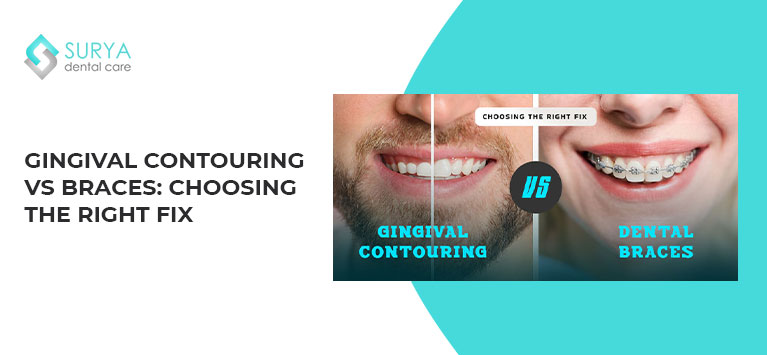If you are planning to straighten your teeth, then you might face the big question that many people struggle to answer, i.e., Which is better, Invisalign vs braces? Orthodontic treatment has come a long way over the years, and today’s patients have more options than ever before.
This blog post helps you to choose one option for your orthodontic treatment by helping you to figure out which is faster, which is more affordable, and which delivers the best results. We’ll also look at the differences between ceramic braces vs. Invisalign, traditional braces vs. Invisalign, and even lingual braces vs. Invisalign, helping you make a well-informed decision about your orthodontic journey.
What Are Invisalign and Braces?
Invisalign is a modern, clear aligner system made from medical-grade flexible thermoplastic material named SmartTrack. Patients wear a series of custom-made, removable trays that gradually shift teeth into place. It’s popular for its discreet appearance. Invisalign may also not work for someone. So consult orthodontics to ensure that it fits you.
Braces are the traditional orthodontic option, using brackets and wires to move teeth. These come in several types,
- Traditional metal braces – the classic type with metal brackets
- Ceramic braces – tooth-colored brackets for a less noticeable look
- Lingual braces – braces placed on the inner side of teeth, hidden from view
Each type of treatment works to achieve the same goal, which is to straighten the teeth, but they differ significantly in how they get there.
Invisalign vs Braces Before and After
Below, we showcase before-and-after images of Invisalign and braces treatments, highlighting how each method delivers beautifully aligned confident smiles over time.

Invisalign vs Braces: Which Is Faster?
One of the most common questions patients have is which type is faster. Whether Invisalign or braces.
The answer isn’t one-size-fits-all. Generally
- Braces tend to work slightly faster for complex cases, such as severe crowding or major bite issues because they apply continuous pressure and can handle more challenging movements.
- Invisalign can be just as fast for mild to moderate cases, often completing treatment in 12 to 18 months. Sometimes, even less for simple adjustments.
However, success with Invisalign heavily depends on patient compliance. Forgetting to wear an Invisalign for the recommended 20–22 hours a day can delay results as they are removable.
Invisalign vs Braces Cost: Which Is More Affordable?
Cost is often the deciding factor. So, when comparing Invisalign vs braces cost, what should you expect?
- Traditional metal braces typically cost between ₹35,000 to ₹65,000 (or $3,000–$7,000, depending on country and provider).
- Ceramic braces are a bit more expensive, ranging from ₹55,000 to ₹85,000 ($4,000–$8,500), because of the aesthetic materials.
- Lingual braces are the most expensive, often ₹90,000 to ₹150,000 ($8,000–$10,000+), due to their complexity and customization.
- Invisalign usually falls in the range of ₹80,000 to ₹200,000 ($4,500–$9,000), depending on case complexity, number of aligners, and provider experience.
While Invisalign is often slightly more expensive than regular braces, many patients find the added comfort and aesthetics worth the investment.
Comfort: Invisalign vs Braces
Nobody wants to go through unnecessary discomfort when straightening their teeth. So choosing the most comfortable one is important.
- Braces (metal, ceramic, or lingual) can irritate the cheeks, lips, and tongue due to the brackets and wires. There’s also some discomfort after adjustments.
- Invisalign aligners are smooth and custom-fitted, which causes less irritation than braces. However, you may still feel pressure or tightness when switching to a new set of trays.
It’s also worth noting that lingual braces cause discomfort at first because they rub against the tongue, particularly when they are hidden.
Aesthetic Appeal: Which Looks Better?
A major reason why many adults prefer Invisalign is its near-invisible appearance.
- Invisalign trays are clear, which makes them invisible.
- Ceramic braces are also discreet, blending in with natural tooth color.
- Lingual braces are entirely hidden behind the teeth.
- Traditional braces are the most visible but can be dressed up with colorful bands if desired.
Ceramic Braces vs Invisalign
Ceramic braces and Invisalign both offer a less noticeable look than metal braces.
- Ceramic braces are fixed to your teeth, so there is no risk of forgetting them. However, they need to be cleaned properly as they can stain over time.
- Invisalign offers the freedom to remove aligners for eating, drinking, and brushing. But it requires discipline to wear consistently.
Traditional Braces vs Invisalign
- Traditional braces are highly effective for all kinds of cases, including severe bite issues.
- Invisalign is ideal for mild to moderate corrections with the added benefit of being removable and discreet.
Lingual Braces vs Invisalign
- Lingual braces are completely hidden but can be difficult to adjust to, especially when speaking.
- Invisalign is also invisible (almost) but much easier to get used to.
Final Thoughts: Which Should You Choose?
Finally, deciding between Invisalign vs braces comes down to,
- Your orthodontic needs
- Your lifestyle and discipline
- Your budget
- Your aesthetic preferences
In the end, no matter what you choose, whether Invisalign or braces. As they both have a proven track record of delivering fantastic results. With today’s advanced orthodontic options, you’re sure to find one that fits your goals, budget, and lifestyle.
The better way is to consult an experienced orthodontist who can assess your teeth and recommend the most effective option. ContactSurya Dental Care to straighten your teeth at an affordable cost with the most experienced orthodontist.









Leave a Comment